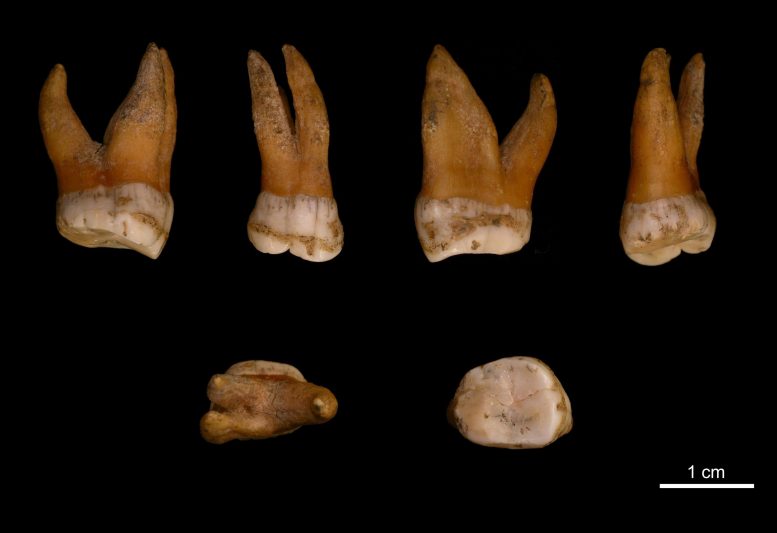通過比較古人類的Y染色體與現代人的Y染色體,研究小組發現,尼安德特人和現代人的Y染色體彼此之間的相似性比與Denisovan Y染色體更相似。 “這對我們來說是一個驚喜。通過研究他們的常染色體DNA,我們可以知道尼安德特人和丹尼索瓦人之間有著密切的聯係,而當今生活的人類是他們更遠的進化表親。在我們第一次查看數據之前,我們希望它們的Y染色體會顯示出相似的圖像。”研究的主要作者馬丁·彼得(Martin Petr)說。研究人員還計算出,尼安德特人和現代人類Y染色體的最新共同祖先大約生活在370,000年前,比以前想象的要新得多。
到現在為止,眾所周知,由於尼安德特人與現代人類之間的雜交大約在50,000-70,000年前,所有具有非非洲血統的人都攜帶少量尼安德特人DNA,這是在現代人類遷出非洲並開始傳播後不久世界各地。但是,尼安德特人是否也可能攜帶一些現代人類DNA一直是一個爭論的問題。這些Y染色體序列現在提供了新的證據,表明尼安德特人和早期的現代人類在非洲大批移民之前就已經相遇並交換了基因-可能早在370,000年前,當然早在100,000年前。這意味著當時與歐亞大陸早期人類有密切關係的某些人口一定已經在歐亞大陸。令人驚訝的是,這種雜交導致了原始尼安德特人Y染色體被現代人類替換,這種模式類似於在早期研究中對尼安德特人線粒體DNA的觀察。
從早期現代人類中選擇Y染色體
首先,早期尼安德特人的Y染色體和mtDNA的完全替換令人費解,因為這樣的替換事件不太可能僅憑偶然發生。然而,研究人員使用計算機模擬結果表明,已知的尼安德特人小種群可能導致其Y染色體上有害突變的積累,這將降低其進化適應性。這與極小的人口規模和近交有時會增加某些疾病的發病率的情況非常相似。 “我們推測,鑒於Y染色體在繁殖和繁殖力中的重要作用,尼安德特人Y染色體進化適應性較低,可能導致自然選擇偏愛早期現代人類的Y染色體,最終導致了它們的替代”。馬丁·彼得(Martin Petr)說。
該研究的資深作者珍妮特·凱爾索(Janet Kelso)樂觀地認為,可以在不久的將來檢驗這種替代假說:“如果我們能夠從假想的早期滲入事件之前存在的尼安德特人中檢索Y染色體序列,例如430,000歲我們預測來自西班牙Sima de los Huesos的尼安德特人仍將擁有原始的尼安德特人Y染色體,因此與Denisovans相比,與現代人類更相似。”
By comparing the archaic human Y chromosomes to each other and to the Y chromosomes of people living today, the team found that Neandertal and modern human Y chromosomes are more similar to one another than they are to Denisovan Y chromosomes. “This was quite a surprise to us. We know from studying their autosomal DNA that Neanderthals and Denisovans were closely related and that humans living today are their more distant evolutionary cousins. Before we first looked at the data, we expected that their Y chromosomes would show a similar picture,” says Martin Petr, the lead author of the study. The researchers also calculated that the most recent common ancestor of Neandertal and modern human Y chromosomes lived around 370,000 years ago, much more recently than previously thought.
It is by now well established that all people with non-African ancestry carry a small amount of Neandertal DNA as a result of interbreeding between Neanderthals and modern humans approximately 50,000-70,000 years ago, quite shortly after modern humans migrated out of Africa and started spreading around the world. However, whether Neanderthals might also carry some modern human DNA has been a matter of some debate. These Y chromosome sequences now provide new evidence that Neanderthals and early modern humans met and exchanged genes before the major out of Africa migration — potentially as early as 370,000 years ago and certainly more than 100,000 years ago. This implies that some population closely related to early modern humans must already have been in Eurasia at that time. Surprisingly, this interbreeding resulted in the replacement of the original Neandertal Y chromosomes with those of early modern humans, a pattern similar to what has been seen for Neandertal mitochondrial DNA in an earlier study.
Selection for Y chromosomes from early modern humans
At first, the complete replacement of both Y chromosomes and mtDNA of early Neanderthals was puzzling, as such replacement events are quite unlikely to occur by chance alone. However, the researchers used computer simulations to show that the known small size of Neandertal populations may have led to an accumulation of deleterious mutations in their Y chromosomes which would reduce their evolutionary fitness. This is quite similar to situations where extremely small population sizes and inbreeding can sometimes increase the incidence of some diseases. “We speculate that given the important role of the Y chromosome in reproduction and fertility, the lower evolutionary fitness of Neandertal Y chromosomes might have caused natural selection to favor the Y chromosomes from early modern humans, eventually leading to their replacement” says Martin Petr.
Janet Kelso, the senior author of the study, is optimistic that this replacement hypothesis could be tested in the near future: “If we can retrieve Y chromosome sequences from Neanderthals that lived prior to this hypothesized early introgression event, such as the 430,000 year old Neanderthals from Sima de los Huesos in Spain, we predict that they would still have the original Neandertal Y chromosome and will therefore be more similar to Denisovans than to modern humans.”
Reference: “The evolutionary history of Neanderthal and Denisovan Y chromosomes” by Martin Petr, Mateja Hajdinjak, Qiaomei Fu, Elena Essel, Hélène Rougier, Isabelle Crevecoeur, Patrick Semal, Liubov V. Golovanova, Vladimir B. Doronichev, Carles Lalueza-Fox, Marco de la Rasilla, Antonio Rosas, Michael V. Shunkov, Maxim B. Kozlikin, Anatoli P. Derevianko, Benjamin Vernot, Matthias Meyer and Janet Kelso, 25 September 2020, Science.
DOI: 10.1126/science.abb6460
